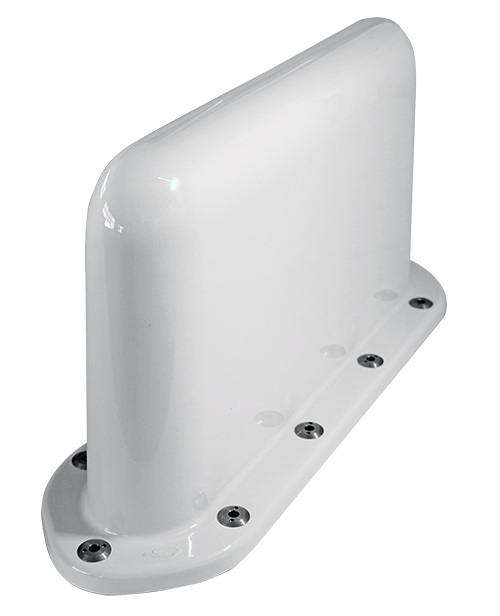Technological advancements have taken the business office to 30,000 feet. Today’s business aircraft passengers can already hold confidential video conferences and Zoom meetings, access their company Intranet and even stream videos without interruption while flying cross-country or around the world, thanks to major advancements in aircraft connectivity.
What’s even more remarkable is that many of these capabilities soon won’t be limited to users of large- and mid-cabin business jets. While high-bandwidth streaming services aren’t available for turboprop passengers yet, they can email and access the internet to perform basic business functions while flying.
With the coming introduction of 5G air-to-ground networks for domestic travelers, as well as upcoming innovations in satellite transmission technologies, experts say aircraft connectivity soon will be as fast as what you find in the typical office.
“We’re getting to the point where we can offer an office-like experience with 5G,” said Dave Mellin, director of public relations and communications at Gogo Business Aviation. “It will be the first time that we can say we have a service that matches what you have on the ground.”
Gogo plans to launch its Gogo 5G air-to-ground (ATG) service later this year. Testing already has begun.
For customers accessing satellite-based services offered via the high-bandwidth Ka and Ku bands, the next step forward in business aviation connectivity is just around the corner.
Intelsat’s FlexExec service offers a global, high-throughput satellite solution worldwide. Built on layers of redundant coverage, travelers can use the service to connect without buffering on their devices, according to Frederik van Essen, Intelsat vice president of business development. The service, which is available through Intelsat’s business aviation service provider, Satcom Direct, will provide office-like internet access to mid- and large-cabin users starting this summer.
“You can be in your business aircraft using the internet as if you are a part of your corporate network,” said van Essen. “Everything works as if you are sitting in your office, but at 30,000 feet.”
These services can’t come fast enough for many users, especially given the increased demand for business aviation during the COVID-19 pandemic.

Additional good news comes in the form of connectivity package pricing. In many cases, the services now offer more flexibility designed around the amount of time and the type of access customers use. And the quality of service overall is expected to increase as prices, in some instances, actually decline.
Cabin Connectivity FAQs
As impressive as recent cabin connectivity advances have been, the array of options can be potentially confusing for some operators, FBOs and aircraft maintenance departments. New ATG and satellite-based services typically will require equipment and service upgrades. To help sort through the options, below are some answers to frequently asked questions about installing a new or upgrading an existing onboard connectivity system.
Which Is Better, ATG or Satellite Systems?
It depends on where the aircraft is flying and its overall mission. ATG services are available only over land, typically in the U.S. and Canada. So, for those flying internationally, a satellite-based system is the only option.
“If you have an aircraft that can fly around the world and you want to have the flexibility to go anywhere whenever you want to go, the only answer is satellite communications,” said van Essen.
Satellite systems offer faster speeds, coverage over land and sea, and work when on the ground. ATG systems typically are lower cost and lower latency.
What Are the Differences Between Ku, Ka or L Band Equipment?
L Band is typically used for safety and navigation services.
“L band also is used by GPS satellites,” said van Essen. “The reason these frequencies are used is that they are very robust and don’t suffer from degradation due to weather. If you need to do safety communications, and things that are absolutely critical like your air traffic control or position data from GPS, then L band is a great frequency to use. But because it’s a lower frequency, there isn’t much bandwidth available.”
Ka and Ku band offer far more bandwidth and are better for streaming, video conferencing and other activities that require more data transmission. They are typically a bit more expensive, but they are the gold standard for inflight internet. However, services are around the corner that will seamlessly access all bands, based on user needs.
“We’re not there right now, but with future multi-orbit, multi-band systems, it will become more transparent from a user perspective,” explained van Essen. “You will not have to make specific band choices going forward.”
In many cases, aircraft size also dictates which band you can utilize. “The GEO satellite systems are so large (antennas and supporting equipment) they only fit on larger-cabin aircraft,” said Mellin. “For smaller aircraft, ATG is your only option today.”
Do Higher Price and Greater Data Throughput Necessarily Mean Better Performance?
Depends on who you ask. Service providers argue that higher-priced services offer better quality and more options for users, but those offering lower-priced services counter that their quality is just as good.
In terms of throughput, “There is no substitute,” said one aircraft operator. “There are some tricks service providers can use to make the user experience better, but more water flows through a bigger hose. That’s just physics.”
What Is Data Latency and How Does it Affect System Performance?
Simply put, latency is the time it takes for data to make the trip to and from the aircraft.
“The longer the path something has to travel, the more time it will take and the longer the latency will be,” explained van Essen.

“For most applications, latency, whether on the ground or in flight, is no problem,” he continued. “If you are sending an email or text message, it’s of no concern. Even in a telephone conversation, it’s hardly a concern. Only if you’re doing online gaming or high-frequency trading online in the stock market, (long latency) could be a problem.”
How Secure Are Airborne Connectivity Systems?
Cybersecurity definitely is improving, say the experts. “You have to remember, the internet you use in the air is the same one you use on the ground,” said the aircraft operator. “If you are not secure on the internet, the bad guys will find you.” For that reason, many providers are backing up their connectivity systems with additional security procedures.
Once I Select the Hardware, What Are the Service Plan Options?
“Good question, but it’s difficult to answer,” said the aircraft operator. “Currently, some providers have unlimited plans, some have data-limited plans, some may have regional limitations, and others yet may limit what you can do. The good news is that with the growing number of providers, there is growing competition. There is probably a plan out there that will fit your needs.”
Where Should I Have My System of Choice Installed?
Basically, it’s best to go to an expert and use a facility you can trust.
“These are usually extensive installations and are often coupled with a large [aircraft] inspection,” said our operator. “If you trust the facility to do your inspection, you will probably be good with the [connectivity] installation as well.”
What Sort of Training Will My Pilots, Flight Attendants and Maintenance Technicians Need to Support a Connectivity System?
Connectivity systems can be complicated. For that reason, most providers offer staff training for maintenance technicians and flight attendants. For example, Satcom Direct provides training for Intelsat’s FlexExec. “They provide a full set of training for both the MROs and the operators,” said van Essen. “They usually have classrooms, or they can go to the customer to provide training.”
If I Already Have a Connectivity System on my Aircraft, What Are my Upgrade Options?
Says our operator: “This depends on your definition of ‘already have connectivity.’ If the aircraft is using an out-of-date system that’s no longer serviced, then you have a wide array of upgrade options.
“However, if you have a current Ka system, you may be capped out until new hardware or software is developed,” says the operator. “ATG has been where the upgrades have been happening. System upgrades have transitioned from 3G to 4G and now 5G.”
How Will the Merger of Satcom Giants Viasat and Inmarsat Affect What Equipment and Services Will Be Available Going Forward?
It’s difficult to tell at this point. For those who don’t know, in November 2021, Viasat announced it was acquiring Inmarsat in a $7.3 billion deal.
The combined company will have a spectrum license portfolio across the Ka, L and S bands and a fleet of 19 satellites in service, with an additional 10 satellites to come in the next three years.
Gogo 5G Coming This Year

 Gogo is the world’s largest provider of broadband connectivity services for the business aviation market, offering a customizable suite of smart cabin systems for highly integrated connectivity, inflight entertainment and voice solutions.
Gogo is the world’s largest provider of broadband connectivity services for the business aviation market, offering a customizable suite of smart cabin systems for highly integrated connectivity, inflight entertainment and voice solutions.
Gogo’s products and services are installed on thousands of business aircraft of all sizes and mission types, from turboprops to international jets. In April, Gogo announced that its AVANCE systems reached 1 million flights since the platform launched in August 2017.
Gogo offers two main products – Avance L3 and Avance L5. The latter offers the easiest upgrade path to Gogo 5G, which will debut in the second half of 2022. Avance L5 is delivering 2- to 7-plus Mbps speeds with very low latency, which is critical for real-time video conferencing applications like Zoom or Microsoft Teams. Gogo 5G will deliver ~25 Mbps on average, with peak speeds between 75-80 Mbps.
Gogo Avance L3 is the company’s most affordable connectivity solution, providing a seamless inflight Wi-Fi experience throughout North America, including portions of Canada and Alaska.
FlexExec a Dedicated Business Aviation Network

Intelsat’s FlexExec is a global, secure, multi-layered broadband satellite connectivity service that delivers consistent, high-performance coverage. FlexExec is designed for business aviation customers, as network capacity is not shared with commercial aviation or consumer broadband customers, which means passengers will have a reliable and consistent connectivity experience anywhere they fly.
As the world’s first global Ku-band high-throughput satellite (HTS) service, FlexExec focuses on high-traffic routes with HTS coverage and layers of wide-beam capacity for added resiliency and redundancy. FlexExec enables maximum customer control and choice through nimble, open architecture solutions, as well as efficient use of bandwidth, which is critical when routes and passenger demand shift unexpectedly.
Additionally, Intelsat remains at the forefront of cybersecurity. It is the only satellite operator certified by an independent auditor for Service Organization Control 3 (SOC 3) compliance.
FlexExec ensures a seamless and reliable passenger experience across every device and application, regardless of how many jets are on the network. The system also offers flexible billing plans for flight departments. FlexExec is available through Satcom Direct, the master distributor of the system.



 International Business Aviation Council Ltd.
International Business Aviation Council Ltd.